
The Project Gutenberg EBook of Cotton, Its Progress from the Field to the
Needle, by Anonymous
This eBook is for the use of anyone anywhere at no cost and with
almost no restrictions whatsoever. You may copy it, give it away or
re-use it under the terms of the Project Gutenberg License included
with this eBook or online at www.gutenberg.org
Title: Cotton, Its Progress from the Field to the Needle
Being a brief sketch of the culture of the plant, its
picking, cleaning, packing, shipment, and manufacture
Author: Anonymous
Release Date: July 27, 2011 [EBook #36870]
Language: English
Character set encoding: ISO-8859-1
*** START OF THIS PROJECT GUTENBERG EBOOK COTTON ***
Produced by Constanze Hofmann and the Online Distributed
Proofreading Team at http://www.pgdp.net (This file was
produced from images generously made available by The
Internet Archive)

BEING A BRIEF SKETCH OF
THE CULTURE OF THE PLANT,
ITS PICKING, CLEANING, PACKING, SHIPMENT, AND MANUFACTURE.
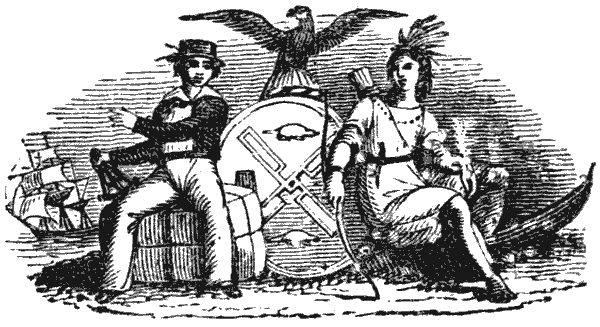
NEW YORK:
PUBLISHED BY ROBERT LOGAN & CO.,
51 DEY-STREET.
1855.
OLIVER & BROTHER, Steam Printers,
No. 32 Beckman-Street, New-York.
Among the utilitarian gifts of nature and art we know of none in more general use, or of greater practical value, than sewing-cotton. The taste which turns into graceful shapes the products of the loom, the executive skill which converts them into convenient and elegant apparel, would be powerless without this simple accessory. It is the food of the needle, and might almost be called the thread of life to thousands of the gentler sex. Yet as it passes through the delicate fingers of mothers, wives, and daughters, ministering to so many wants, and creating so many beautiful superfluities, little thought is bestowed upon the labor, the care, the dexterity, and the scientific ability required in producing the article. The cultivation of the raw material, the processes of picking, ginning, packing, shipping, combing, spinning, and twisting, are among the most interesting operations in the whole range of agriculture and manufactures; and we think the ladies, for whose especial convenience such a vast amount of industry, skill, and talent is employed, will not be unwilling to trace with us in a familiar way the progress of this great domestic staple from the field to the needle.
We therefore claim their attention to the following short treatise, from which, without being fatigued by dry details, they may derive a tolerably accurate idea of what capital, labor, and science have done to bring to its present perfection the simple article of sewing-cotton.
The cotton-planting season in all the Southern States commences in April. The seed is sown in drills, a negro girl following the light plough which makes the furrow, and throwing the seed into the shallow trench as she moves along. A harrow follows to cover up the deposits, and the work of "planting" is completed. About two and a half bushels of seed are required for an acre of ground.
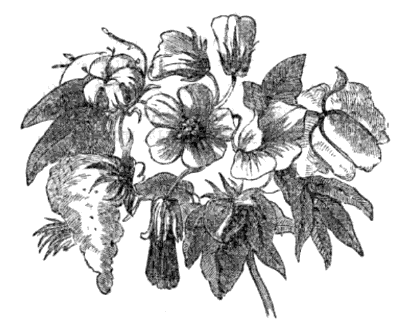
In a week or ten days the cotton is "up," when a small plough is run along the drills, throwing the earth from the tender plants. The next process is "scraping;" in other words, thinning out and earthing up the plants, so as to leave each in the centre of a little hill, some two feet distant from its nearest neighbors. The dexterity and accuracy with which this feat is accomplished are wonderful; and there are few [5]spectacles more animated and picturesque than that of a hundred active field-hands flourishing their bright hoes among the young vegetation, each striving to outstrip the others in "hoeing out his row." Several ploughings and hoeings intervene between the first of May and the last of June.
In July the cotton fields burst into bloom, creaming the landscape with a sea of blossoms, the flower being very nearly of the same tint as the ultimate product in its unbleached state. The new beauty thus imparted to the scenery is, however, ephemeral. The blossoms unfold in the night, are in their full glory in the morning, and by noon have begun to fade. On the following day their cream-color has changed to a dull red, and before sunset the petals have fallen, leaving inclosed in the calyx the germ or "form" of the filamental fruit.
The cotton plant, in its progress towards maturity, is liable to the assaults of as many enemies as the young crocodile on the banks of the Nile; but among them all, the "army-worm" is the most destructive. This worm is produced from the eggs of a chocolate-colored moth of particularly harmless and demure appearance; but its name is legion, its ravages terrific. No one who has beheld an invasion of these caterpillars can ever forget it. Deep trenches are dug to arrest their progress, but these are soon filled up by the accumulating myriads; and onward move the living destroyers over the bodies of the buried masses. Huge logs are drawn through the trenches by yokes of oxen, and the multitudinous swarms crushed to a paste, of which the effluvium taints the air for miles; but still the incursion, if checked, is not arrested. When the planter sees the army-worm in his fields, he is ready to give up his crop in despair.
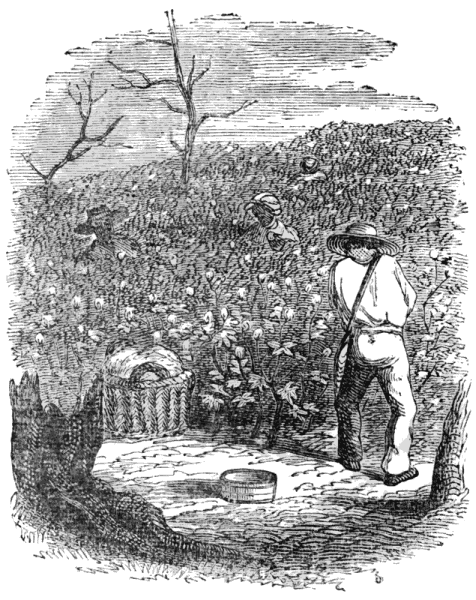
By the middle of July the "bolls" or "forms" begin to open; and the cotton fields, when viewed from a short distance, present the appearance of being covered with ridges of white[6] surf. Toward the close of the month the picking season commences, and is continued without intermission until the Christmas holidays. Each field-hand is supplied with a basket and a bag. The basket is placed at the end of the cotton row, and the bag, as fast as filled, is emptied into it. It is a pleasant sight, on "the old plantation," to see the pickers returning at nightfall from their work, with their well-filled baskets picturesquely poised upon their woolly heads. Falling into line with the stoutest in the van, they move along through the twilight, too tired to talk or sing, anxious only to deposit their store in the packing-house, and retire to their "quarters" to rest. A first-rate hand will pick from three hundred to three hundred and fifty pounds of cotton per day.
The next process is the "ginning," or separation of the cotton from the seeds. The invention of the cotton-gin by Eli Whitney, a New England youth, in 1793, marked a new epoch in the cotton trade, and at once more than quadrupled the value of the article as a national staple. Arkwright had already introduced the spinning-frame, and through the genial influence of these two great inventions, a pound of cotton, formerly spun tediously by hand into a thread of five hundred feet, was lengthened into a filament of one hundred[7] and fifty miles; and the value of our cotton exports was increased in sixty years from fifty thousand to one hundred and twelve millions of dollars!
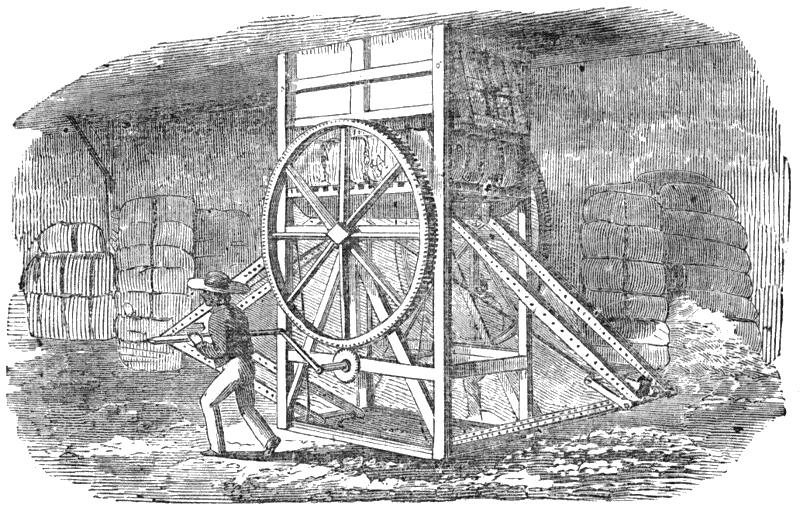
PACKING PRESS.
[8]After the "ginning" comes the "baling" of the cotton, which ends the labor bestowed upon it on the plantation. In this process powerful screw-presses are employed. The cotton is inclosed in Kentucky bagging, and the contents of each bale are compressed by the screw almost to the solidity of stone. The cotton is now ready for market.
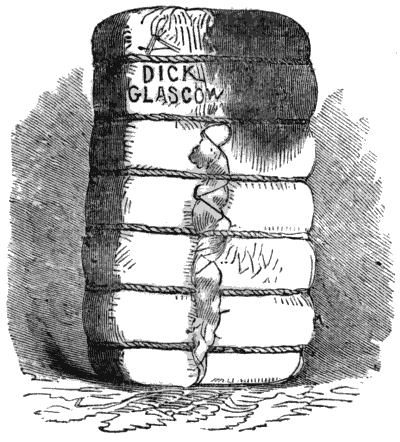
Toward the close of the packing season there are jolly times on the plantation. Fox-hunting and racing are the order of the day. The Southern planter, like the "fine old English gentleman," opens house to all, and all goes "merry as a marriage bell." Sambo rubs up his old musket, and is out after the ducks, while Dinah's shining face wears an extra gloss in anticipation of the holidays. Throughout the holidays there is high festival in the negro quarters. "The shovel and the hoe" are laid down, and the fiddle is continually going. So ends the cotton season.
The cotton, being packed, is to be sent to market. For this purpose it is "hauled," generally by oxen, to the nearest landing on the river, where the bales are rolled down the banks and stowed on board freight boats bound to New Orleans or Mobile. This process is technically called "bumping." There are certain plantations famous for the tenacious and beautiful quality of their cotton, from which the supplies for Dick & Sons' celebrated sewing-cotton mills at Glasgow are principally derived.
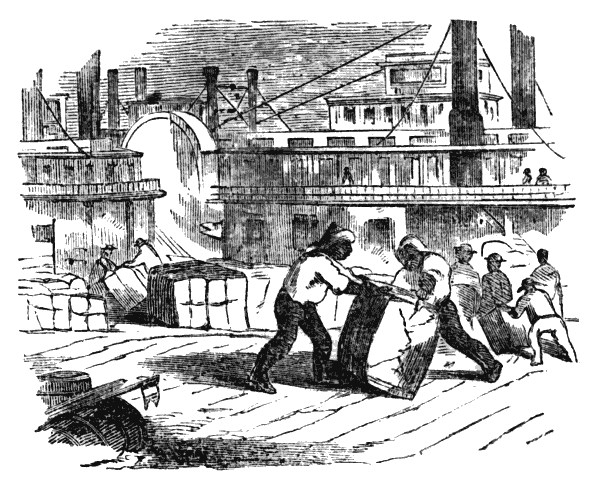
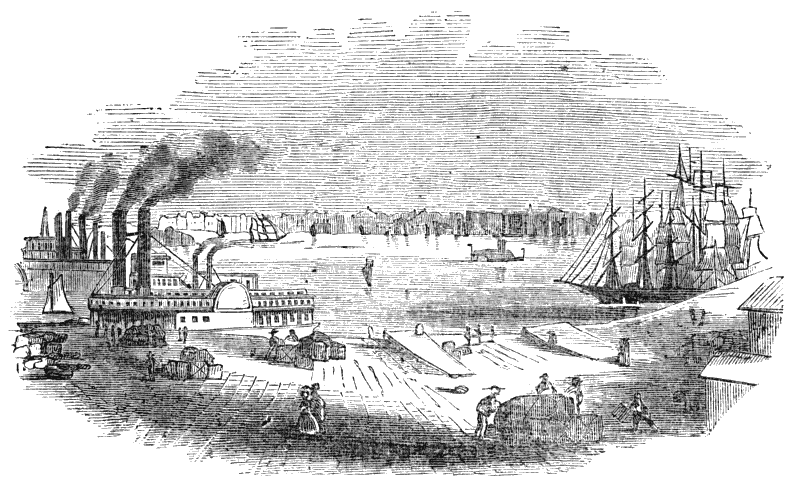
It would be difficult to describe the scene of bustle and seeming confusion presented by the levee at New Orleans when the bulk of the new crop begins to come in. The songs and clamor of the negro stevedores, at work in the holds and on the decks of the vessels; the sharp authoritative expletives of the overseers and masters; the eager conversations of the merchants, and the[10] preternatural activity into which the occasion seems to have spurred all the energies of Southern life, are to Northern ears and eyes at once amusing and confounding. But order reigns amidst this seeming chaos. The Mississippi boats are rapidly relieved of their bulky cargoes, and the cotton is warehoused or re-shipped, as the case may be, with marvellous celerity.[11] Generally the shipments for the Clyde Mills, Glasgow, are among the first of the season; and the primest article in the market is always selected for Dick & Sons by the New Orleans agents of the firm.
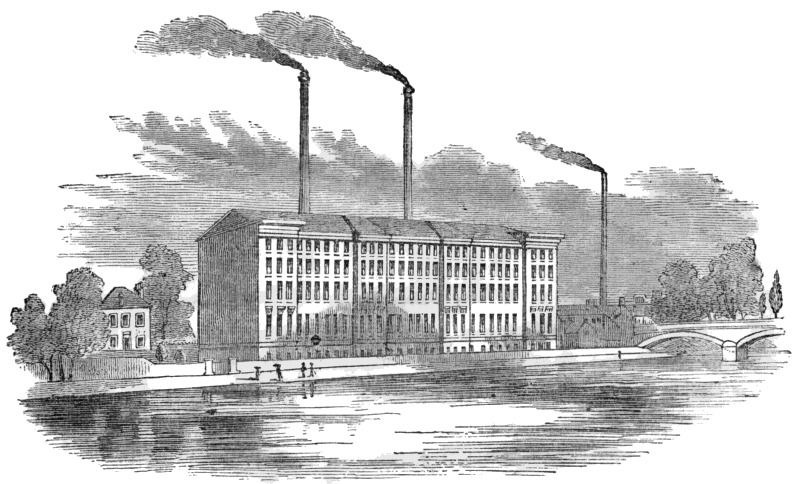
DICK & SONS' CLYDE THREAD-MILLS.
The view of the Clyde Thread-Mills, furnished by our engraver from accurate drawings[12] taken on the spot, affords a very good idea of the extensive manufactory of Dick & Sons, from which this country is now supplied with the most perfect, even, and tenacious sewing-cotton made in the world. The cotton for the mills, after having been unloaded and inspected by the revenue officers, is conveyed at once to the mills, where there is an immense amount of warehouse room for the raw material, independent of the space devoted to machinery and the storage of the manufactured article. Of the latter, however, there is never a large accumulation, the active and ever-increasing demand taxing to the utmost the facilities of production, great as they are.
A full description of the processes of scutching, carding, spinning, twisting, bleaching, and spooling, through all of which the cotton passes before it is packed for exportation in the form of thread, would require more space than we can devote to them in this treatise, and, moreover, would be rather dry reading for the ladies, for whose information and amusement this little publication is intended. It is sufficient to say, that all the latest improvements in machinery, in each of the above branches, have been introduced at the Clyde Works; and that as regards the perfection of their mechanical facilities, as well as in point of capacity, they have no rivals in the United Kingdom.[13]
The consignments of Dick & Sons' spool-cotton to this city are on a scale of magnitude which those who have never reflected upon the immense and universal consumption of the article would scarcely believe. The bulk of the importations is received by the Collins' line of steamers, and delivered at the Collins' wharf, whence it is conveyed to the New York agency of the firm, 51 Dey-street. To the trade it is unnecessary to say, that Dick & Sons' six-cord spool-cotton is the best in the market; and ladies generally are aware that in strength, uniformity of thickness, and closeness of fibre, it is superior to any other sewing-thread in use.
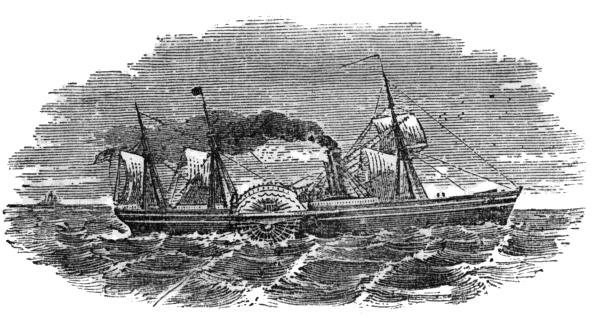
Mr. Dick, senior, has probably had more experience as a manufacturer of the article than any[14] other man living. Prior to commencing business on his own account he had been for nearly thirty years the manager of a factory celebrated for producing a superior description of sewing-cotton, also well known in the United States. Hence the cotton of Dick & Sons came into the market with a ready-made popularity. The name of Mr. Dick was a guarantee of its excellence,[15] and a large demand for it spontaneously sprang up in the United States, Canada, the West Indies, and the British possessions in India, and throughout the world.
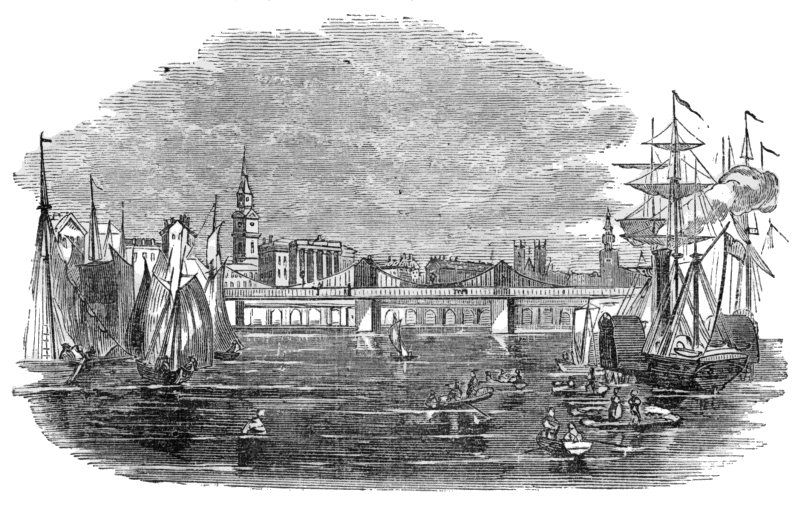
Infinite pains are taken to retain for the article the celebrity it has acquired. Every spool is inspected before it leaves the factory at Glasgow, so that no defective specimens can possibly reach the hands of consumers.
The history of the culture of cotton, and of its application to the uses of man, forms an almost romantic episode in the annals of agriculture, commerce, and manufactures. We have already mentioned the extraordinary impetus given to its production, sale, and use by the introduction of Whitney's saw-gin, for separating the seeds from the wool, in the years 1793 and 1794. Since that time the progress of the demand and consumption has been no less wonderful.
In 1794 the export rose from 187,000 lbs., the sum total for the previous year, to 1,601,760 lbs. The next year it was over 6,000,000 lbs. In 1800 it had advanced to about 18,000,000 lbs., and in 1810 to upwards of 93,000,000 lbs. The last returns before us are for 1852, when the export of the short staple variety alone exceeded one thousand one hundred millions of pounds! To this aggregate we suppose about one hundred millions of pounds may be added for the sea-island and other long-fibred cottons.
It may well be doubted whether among all the fabrics into which this enormous amount of raw material is converted there is one more valuable than sewing-cotton. We think if the[16] question were put to the ladies to-morrow, whether the textile fabrics produced from cotton, or cotton sewing-thread, were the most indispensable to their comfort and convenience, every thimbled hand would be held up in favor of the latter. Sewing-silk is too expensive for ordinary exigencies, and linen thread cannot be spun of the same smooth and even fibre as cotton thread; and besides, being liable to knot and twist, is apt to cut the lighter and more fragile products of the loom. Abolish sewing-cotton, and you abolish muslin embroidery and innumerable delicate and fairy-like embellishments of female loveliness, which taste and fashion have endorsed.
Every lady is by habit a connoisseur in the article. She examines the spools with a critical eye; she tries the strength of the thread; she passes it through her fingers to test its evenness and compactness, and when seated at her work, detects in a moment any defects which may have been overlooked by the manufacturer.
To this ordeal the six-cord cotton-thread of Dick & Sons is cheerfully submitted. It challenges inspection and comparison. There is little necessity, however, for an appeal to the ladies in relation to its good qualities, for they have them already at their fingers' ends.
End of the Project Gutenberg EBook of Cotton, Its Progress from the Field to
the Needle, by Anonymous
*** END OF THIS PROJECT GUTENBERG EBOOK COTTON ***
***** This file should be named 36870-h.htm or 36870-h.zip *****
This and all associated files of various formats will be found in:
http://www.gutenberg.org/3/6/8/7/36870/
Produced by Constanze Hofmann and the Online Distributed
Proofreading Team at http://www.pgdp.net (This file was
produced from images generously made available by The
Internet Archive)
Updated editions will replace the previous one--the old editions
will be renamed.
Creating the works from public domain print editions means that no
one owns a United States copyright in these works, so the Foundation
(and you!) can copy and distribute it in the United States without
permission and without paying copyright royalties. Special rules,
set forth in the General Terms of Use part of this license, apply to
copying and distributing Project Gutenberg-tm electronic works to
protect the PROJECT GUTENBERG-tm concept and trademark. Project
Gutenberg is a registered trademark, and may not be used if you
charge for the eBooks, unless you receive specific permission. If you
do not charge anything for copies of this eBook, complying with the
rules is very easy. You may use this eBook for nearly any purpose
such as creation of derivative works, reports, performances and
research. They may be modified and printed and given away--you may do
practically ANYTHING with public domain eBooks. Redistribution is
subject to the trademark license, especially commercial
redistribution.
*** START: FULL LICENSE ***
THE FULL PROJECT GUTENBERG LICENSE
PLEASE READ THIS BEFORE YOU DISTRIBUTE OR USE THIS WORK
To protect the Project Gutenberg-tm mission of promoting the free
distribution of electronic works, by using or distributing this work
(or any other work associated in any way with the phrase "Project
Gutenberg"), you agree to comply with all the terms of the Full Project
Gutenberg-tm License (available with this file or online at
http://gutenberg.org/license).
Section 1. General Terms of Use and Redistributing Project Gutenberg-tm
electronic works
1.A. By reading or using any part of this Project Gutenberg-tm
electronic work, you indicate that you have read, understand, agree to
and accept all the terms of this license and intellectual property
(trademark/copyright) agreement. If you do not agree to abide by all
the terms of this agreement, you must cease using and return or destroy
all copies of Project Gutenberg-tm electronic works in your possession.
If you paid a fee for obtaining a copy of or access to a Project
Gutenberg-tm electronic work and you do not agree to be bound by the
terms of this agreement, you may obtain a refund from the person or
entity to whom you paid the fee as set forth in paragraph 1.E.8.
1.B. "Project Gutenberg" is a registered trademark. It may only be
used on or associated in any way with an electronic work by people who
agree to be bound by the terms of this agreement. There are a few
things that you can do with most Project Gutenberg-tm electronic works
even without complying with the full terms of this agreement. See
paragraph 1.C below. There are a lot of things you can do with Project
Gutenberg-tm electronic works if you follow the terms of this agreement
and help preserve free future access to Project Gutenberg-tm electronic
works. See paragraph 1.E below.
1.C. The Project Gutenberg Literary Archive Foundation ("the Foundation"
or PGLAF), owns a compilation copyright in the collection of Project
Gutenberg-tm electronic works. Nearly all the individual works in the
collection are in the public domain in the United States. If an
individual work is in the public domain in the United States and you are
located in the United States, we do not claim a right to prevent you from
copying, distributing, performing, displaying or creating derivative
works based on the work as long as all references to Project Gutenberg
are removed. Of course, we hope that you will support the Project
Gutenberg-tm mission of promoting free access to electronic works by
freely sharing Project Gutenberg-tm works in compliance with the terms of
this agreement for keeping the Project Gutenberg-tm name associated with
the work. You can easily comply with the terms of this agreement by
keeping this work in the same format with its attached full Project
Gutenberg-tm License when you share it without charge with others.
1.D. The copyright laws of the place where you are located also govern
what you can do with this work. Copyright laws in most countries are in
a constant state of change. If you are outside the United States, check
the laws of your country in addition to the terms of this agreement
before downloading, copying, displaying, performing, distributing or
creating derivative works based on this work or any other Project
Gutenberg-tm work. The Foundation makes no representations concerning
the copyright status of any work in any country outside the United
States.
1.E. Unless you have removed all references to Project Gutenberg:
1.E.1. The following sentence, with active links to, or other immediate
access to, the full Project Gutenberg-tm License must appear prominently
whenever any copy of a Project Gutenberg-tm work (any work on which the
phrase "Project Gutenberg" appears, or with which the phrase "Project
Gutenberg" is associated) is accessed, displayed, performed, viewed,
copied or distributed:
This eBook is for the use of anyone anywhere at no cost and with
almost no restrictions whatsoever. You may copy it, give it away or
re-use it under the terms of the Project Gutenberg License included
with this eBook or online at www.gutenberg.org
1.E.2. If an individual Project Gutenberg-tm electronic work is derived
from the public domain (does not contain a notice indicating that it is
posted with permission of the copyright holder), the work can be copied
and distributed to anyone in the United States without paying any fees
or charges. If you are redistributing or providing access to a work
with the phrase "Project Gutenberg" associated with or appearing on the
work, you must comply either with the requirements of paragraphs 1.E.1
through 1.E.7 or obtain permission for the use of the work and the
Project Gutenberg-tm trademark as set forth in paragraphs 1.E.8 or
1.E.9.
1.E.3. If an individual Project Gutenberg-tm electronic work is posted
with the permission of the copyright holder, your use and distribution
must comply with both paragraphs 1.E.1 through 1.E.7 and any additional
terms imposed by the copyright holder. Additional terms will be linked
to the Project Gutenberg-tm License for all works posted with the
permission of the copyright holder found at the beginning of this work.
1.E.4. Do not unlink or detach or remove the full Project Gutenberg-tm
License terms from this work, or any files containing a part of this
work or any other work associated with Project Gutenberg-tm.
1.E.5. Do not copy, display, perform, distribute or redistribute this
electronic work, or any part of this electronic work, without
prominently displaying the sentence set forth in paragraph 1.E.1 with
active links or immediate access to the full terms of the Project
Gutenberg-tm License.
1.E.6. You may convert to and distribute this work in any binary,
compressed, marked up, nonproprietary or proprietary form, including any
word processing or hypertext form. However, if you provide access to or
distribute copies of a Project Gutenberg-tm work in a format other than
"Plain Vanilla ASCII" or other format used in the official version
posted on the official Project Gutenberg-tm web site (www.gutenberg.org),
you must, at no additional cost, fee or expense to the user, provide a
copy, a means of exporting a copy, or a means of obtaining a copy upon
request, of the work in its original "Plain Vanilla ASCII" or other
form. Any alternate format must include the full Project Gutenberg-tm
License as specified in paragraph 1.E.1.
1.E.7. Do not charge a fee for access to, viewing, displaying,
performing, copying or distributing any Project Gutenberg-tm works
unless you comply with paragraph 1.E.8 or 1.E.9.
1.E.8. You may charge a reasonable fee for copies of or providing
access to or distributing Project Gutenberg-tm electronic works provided
that
- You pay a royalty fee of 20% of the gross profits you derive from
the use of Project Gutenberg-tm works calculated using the method
you already use to calculate your applicable taxes. The fee is
owed to the owner of the Project Gutenberg-tm trademark, but he
has agreed to donate royalties under this paragraph to the
Project Gutenberg Literary Archive Foundation. Royalty payments
must be paid within 60 days following each date on which you
prepare (or are legally required to prepare) your periodic tax
returns. Royalty payments should be clearly marked as such and
sent to the Project Gutenberg Literary Archive Foundation at the
address specified in Section 4, "Information about donations to
the Project Gutenberg Literary Archive Foundation."
- You provide a full refund of any money paid by a user who notifies
you in writing (or by e-mail) within 30 days of receipt that s/he
does not agree to the terms of the full Project Gutenberg-tm
License. You must require such a user to return or
destroy all copies of the works possessed in a physical medium
and discontinue all use of and all access to other copies of
Project Gutenberg-tm works.
- You provide, in accordance with paragraph 1.F.3, a full refund of any
money paid for a work or a replacement copy, if a defect in the
electronic work is discovered and reported to you within 90 days
of receipt of the work.
- You comply with all other terms of this agreement for free
distribution of Project Gutenberg-tm works.
1.E.9. If you wish to charge a fee or distribute a Project Gutenberg-tm
electronic work or group of works on different terms than are set
forth in this agreement, you must obtain permission in writing from
both the Project Gutenberg Literary Archive Foundation and Michael
Hart, the owner of the Project Gutenberg-tm trademark. Contact the
Foundation as set forth in Section 3 below.
1.F.
1.F.1. Project Gutenberg volunteers and employees expend considerable
effort to identify, do copyright research on, transcribe and proofread
public domain works in creating the Project Gutenberg-tm
collection. Despite these efforts, Project Gutenberg-tm electronic
works, and the medium on which they may be stored, may contain
"Defects," such as, but not limited to, incomplete, inaccurate or
corrupt data, transcription errors, a copyright or other intellectual
property infringement, a defective or damaged disk or other medium, a
computer virus, or computer codes that damage or cannot be read by
your equipment.
1.F.2. LIMITED WARRANTY, DISCLAIMER OF DAMAGES - Except for the "Right
of Replacement or Refund" described in paragraph 1.F.3, the Project
Gutenberg Literary Archive Foundation, the owner of the Project
Gutenberg-tm trademark, and any other party distributing a Project
Gutenberg-tm electronic work under this agreement, disclaim all
liability to you for damages, costs and expenses, including legal
fees. YOU AGREE THAT YOU HAVE NO REMEDIES FOR NEGLIGENCE, STRICT
LIABILITY, BREACH OF WARRANTY OR BREACH OF CONTRACT EXCEPT THOSE
PROVIDED IN PARAGRAPH 1.F.3. YOU AGREE THAT THE FOUNDATION, THE
TRADEMARK OWNER, AND ANY DISTRIBUTOR UNDER THIS AGREEMENT WILL NOT BE
LIABLE TO YOU FOR ACTUAL, DIRECT, INDIRECT, CONSEQUENTIAL, PUNITIVE OR
INCIDENTAL DAMAGES EVEN IF YOU GIVE NOTICE OF THE POSSIBILITY OF SUCH
DAMAGE.
1.F.3. LIMITED RIGHT OF REPLACEMENT OR REFUND - If you discover a
defect in this electronic work within 90 days of receiving it, you can
receive a refund of the money (if any) you paid for it by sending a
written explanation to the person you received the work from. If you
received the work on a physical medium, you must return the medium with
your written explanation. The person or entity that provided you with
the defective work may elect to provide a replacement copy in lieu of a
refund. If you received the work electronically, the person or entity
providing it to you may choose to give you a second opportunity to
receive the work electronically in lieu of a refund. If the second copy
is also defective, you may demand a refund in writing without further
opportunities to fix the problem.
1.F.4. Except for the limited right of replacement or refund set forth
in paragraph 1.F.3, this work is provided to you 'AS-IS' WITH NO OTHER
WARRANTIES OF ANY KIND, EXPRESS OR IMPLIED, INCLUDING BUT NOT LIMITED TO
WARRANTIES OF MERCHANTIBILITY OR FITNESS FOR ANY PURPOSE.
1.F.5. Some states do not allow disclaimers of certain implied
warranties or the exclusion or limitation of certain types of damages.
If any disclaimer or limitation set forth in this agreement violates the
law of the state applicable to this agreement, the agreement shall be
interpreted to make the maximum disclaimer or limitation permitted by
the applicable state law. The invalidity or unenforceability of any
provision of this agreement shall not void the remaining provisions.
1.F.6. INDEMNITY - You agree to indemnify and hold the Foundation, the
trademark owner, any agent or employee of the Foundation, anyone
providing copies of Project Gutenberg-tm electronic works in accordance
with this agreement, and any volunteers associated with the production,
promotion and distribution of Project Gutenberg-tm electronic works,
harmless from all liability, costs and expenses, including legal fees,
that arise directly or indirectly from any of the following which you do
or cause to occur: (a) distribution of this or any Project Gutenberg-tm
work, (b) alteration, modification, or additions or deletions to any
Project Gutenberg-tm work, and (c) any Defect you cause.
Section 2. Information about the Mission of Project Gutenberg-tm
Project Gutenberg-tm is synonymous with the free distribution of
electronic works in formats readable by the widest variety of computers
including obsolete, old, middle-aged and new computers. It exists
because of the efforts of hundreds of volunteers and donations from
people in all walks of life.
Volunteers and financial support to provide volunteers with the
assistance they need, are critical to reaching Project Gutenberg-tm's
goals and ensuring that the Project Gutenberg-tm collection will
remain freely available for generations to come. In 2001, the Project
Gutenberg Literary Archive Foundation was created to provide a secure
and permanent future for Project Gutenberg-tm and future generations.
To learn more about the Project Gutenberg Literary Archive Foundation
and how your efforts and donations can help, see Sections 3 and 4
and the Foundation web page at http://www.pglaf.org.
Section 3. Information about the Project Gutenberg Literary Archive
Foundation
The Project Gutenberg Literary Archive Foundation is a non profit
501(c)(3) educational corporation organized under the laws of the
state of Mississippi and granted tax exempt status by the Internal
Revenue Service. The Foundation's EIN or federal tax identification
number is 64-6221541. Its 501(c)(3) letter is posted at
http://pglaf.org/fundraising. Contributions to the Project Gutenberg
Literary Archive Foundation are tax deductible to the full extent
permitted by U.S. federal laws and your state's laws.
The Foundation's principal office is located at 4557 Melan Dr. S.
Fairbanks, AK, 99712., but its volunteers and employees are scattered
throughout numerous locations. Its business office is located at
809 North 1500 West, Salt Lake City, UT 84116, (801) 596-1887, email
business@pglaf.org. Email contact links and up to date contact
information can be found at the Foundation's web site and official
page at http://pglaf.org
For additional contact information:
Dr. Gregory B. Newby
Chief Executive and Director
gbnewby@pglaf.org
Section 4. Information about Donations to the Project Gutenberg
Literary Archive Foundation
Project Gutenberg-tm depends upon and cannot survive without wide
spread public support and donations to carry out its mission of
increasing the number of public domain and licensed works that can be
freely distributed in machine readable form accessible by the widest
array of equipment including outdated equipment. Many small donations
($1 to $5,000) are particularly important to maintaining tax exempt
status with the IRS.
The Foundation is committed to complying with the laws regulating
charities and charitable donations in all 50 states of the United
States. Compliance requirements are not uniform and it takes a
considerable effort, much paperwork and many fees to meet and keep up
with these requirements. We do not solicit donations in locations
where we have not received written confirmation of compliance. To
SEND DONATIONS or determine the status of compliance for any
particular state visit http://pglaf.org
While we cannot and do not solicit contributions from states where we
have not met the solicitation requirements, we know of no prohibition
against accepting unsolicited donations from donors in such states who
approach us with offers to donate.
International donations are gratefully accepted, but we cannot make
any statements concerning tax treatment of donations received from
outside the United States. U.S. laws alone swamp our small staff.
Please check the Project Gutenberg Web pages for current donation
methods and addresses. Donations are accepted in a number of other
ways including checks, online payments and credit card donations.
To donate, please visit: http://pglaf.org/donate
Section 5. General Information About Project Gutenberg-tm electronic
works.
Professor Michael S. Hart is the originator of the Project Gutenberg-tm
concept of a library of electronic works that could be freely shared
with anyone. For thirty years, he produced and distributed Project
Gutenberg-tm eBooks with only a loose network of volunteer support.
Project Gutenberg-tm eBooks are often created from several printed
editions, all of which are confirmed as Public Domain in the U.S.
unless a copyright notice is included. Thus, we do not necessarily
keep eBooks in compliance with any particular paper edition.
Most people start at our Web site which has the main PG search facility:
http://www.gutenberg.org
This Web site includes information about Project Gutenberg-tm,
including how to make donations to the Project Gutenberg Literary
Archive Foundation, how to help produce our new eBooks, and how to
subscribe to our email newsletter to hear about new eBooks.